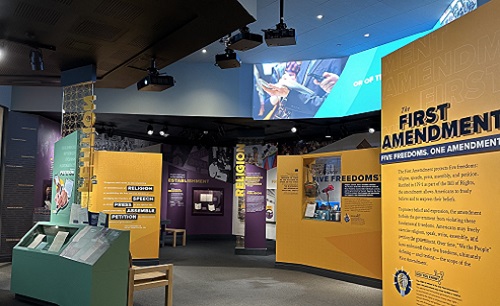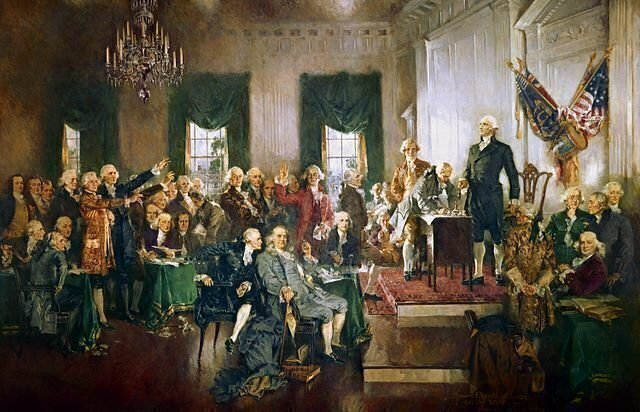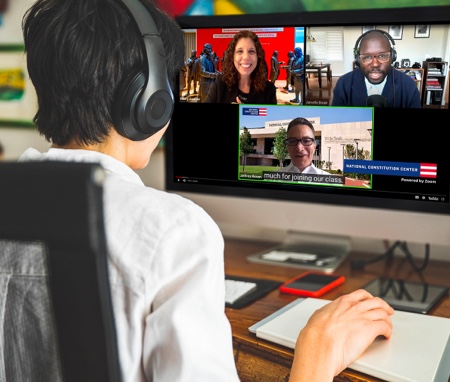
Constitution 101 Course
Start your constitutional learning journey


In the summer of 1787, delegates gathered for a convention in Philadelphia, with the goal of revising the Articles of Confederation—the nation’s existing governing document. However, rather than simply revising the Articles of Confederation, they wrote an entirely new framework of government: the U.S. Constitution. This new government was more powerful than the national government established by the Articles of Confederation, but the Constitution also limited the powers of this new government. In this module, you will explore the debates and compromises that occurred at the Constitutional Convention and explore the key arguments during the battle over ratification.
Purpose
By early May 1787, delegates from the states began to gather in Philadelphia to discuss the current framework of government—the Articles of Confederation. In this activity, you will begin to meet the framers of the Constitution and explore the task before them. The purpose of the activity is to discover who these delegates were and why they came to Philadelphia. You will also learn more about the delegates themselves.
Process
Read the following statement from the Confederation Congress calling for a convention. Then summarize, in your own words, the purpose of the Constitutional Convention. Be prepared to share your summary with the class.
“That it be recommended to the States composing the Union that a convention of representatives from the said States respectively be held at ------ on ------ for the purpose of revising the Articles of Confederation and perpetual Union between the United States of America and reporting to the United States in Congress assembled and to the States respectively such alterations and amendments of the said Articles of Confederation as the representatives met in such convention shall judge proper and necessary to render them adequate to the preservation and support of the Union.”
Next, look closely at the iconic image below that depicts the Constitutional Convention and discuss the following questions with a partner:

Oil painting of the scene at the signing of the Constitution by Howard Chandler Christy, 1940
Then review the information about the delegates in attendance on the Meet the Framers of the Constitution webpage for more information on who was in attendance during the Constitutional Convention.
Finally, complete the Activity Guide: Convention Facts worksheet.
Launch Information
Give students time to read the quote, review the image, and consider the questions.
Ask students to share their summaries and prior knowledge about the Constitutional Convention.
Activity Synthesis
Ask the students to predict how the background and experiences of the delegates might affect the government they form at the Constitutional Convention.
Activity Extension (optional)
For more information, invite students to read The Constitutional Convention of 1787: A Revolution in Government essay on the National Constitution Center website.
Purpose
In this activity, you will continue to explore the delegates who attended the Constitutional Convention. The purpose of this assignment is for you to get to know one influential delegate well and then determine his influence in comparison to other key delegates at the Convention.
Process
Now that you have a general idea of the delegates to the Constitutional Convention, let’s get personal. Review the Info Brief: List of Delegates document to learn more. You will be assigned a delegate to research. Use the Activity Guide: Constitutional Convention - Meet the Framers activity guide to summarize significant information about that person.
You can find additional Information in the The Constitutional Convention of 1787: A Revolution in Government essay by Richard R. Beeman.
After you complete the worksheet, you will present your assigned delegate to the class and advocate for them to be a top influencer at the Convention. Only five will make it to the top influencers list so do your best to make the case of why your delegate should be among them.
Launch Information
This assignment is to help the students learn more about who was in the room when the Constitution was written.
Here are some resources that may be useful to supplement research:
Activity Synthesis
As students present their delegate, you may have them complete a rubric, or some kind of score card and then have students vote, or use a “March Madness” bracket game, to select the top winners for the class.
Activity Extension (optional)
Now that students have a better understanding of the delegates to the Constitutional Convention, invite students to investigate one of the delegates they heard about during the presentations and are interested in but did not research. Focus on their life before and after the Constitutional Convention.
Purpose
In this activity, you will explore the compromises of the Constitutional Convention. You will also learn more about the people who wrote the Constitution.
Process
Watch the following video about the Constitutional Convention.
Then, complete the Video Reflection: Constitutional Convention worksheet.
Identify any areas that are unclear to you or where you would like further explanation. Be prepared to discuss your answers in a group and to ask your teacher any remaining questions.
Launch
Give students time to watch the video and complete the worksheet.
Activity Synthesis
Have students review their worksheet responses and discuss as necessary.
Activity Extension (optional)
Now that students have a better understanding of the Constitutional Convention, ask the following questions:
Purpose
There were many disputes between the states during the convention. Disputes between small states and large states spurred intense debates over how the states were to be represented in the new government. In this activity, you will explore the key compromises that were made at the Constitutional Convention.
Process
Review the Info Brief: Compromises of the Convention document to learn more about the many compromises made during the Convention.
In your small groups, complete the Activity Guide: Compromise Analysis worksheet to identify elements that make each compromise strong and weak.
Be prepared to discuss your analysis with the rest of the class.
Launch
Introduce the significant issues that delegates deliberated about at the Constitutional Convention leading to compromise.
Help students pull in content from the Meet the Framers activity to add to their understanding of the compromises and the key authors and opponents. The activity will allow students to explore the debates between the delegates and why the compromise was important.
Activity Synthesis
Have students review their analyses and discuss as necessary.
Activity Extension (optional)
Now that students have a better understanding of compromises at the Constitutional Convention, ask students to select which compromise listed they believe was most significant to the forming of the United States and explain why.
Purpose
Now that the delegates have drafted the Constitution, what happens next?
“A republic, if you can keep it.” - Ben Franklin
First, the American people had to ratify the new constitution. In this activity, you will examine the process it took to ratify the Constitution and the key arguments for and against the ratification. This will support understanding and build perspective on who was for and against the Constitution, their arguments, and what became the key compromise to win ratification.
Process
In your groups, review the Info Brief: Ratification Timeline document.
You will be assigned to one of the two sides:
Review the Primary Source: Who were the Federalists and the Anti-Federalists? readings from key authors from the Founders’ Library and begin to build a case for why the Constitution should be ratified or rejected.
Determine a pro/con list for ratification and whether you wish to argue for or against ratifying the Constitution (saying yes or no to adoption). Identify quotes to support your side’s argument.
After group research is complete, you will engage in a classroom debate about ratification. Groups need to prepare information for each of the three debate rounds:
Each group will be given three minutes to present their case. Then, they will have a one-minute rebuttal to address points made by the other side.
After the debate is finished, identify compromises that could be reached to achieve agreement between the two sides and lead to ratification.
Launch
Review with the class the Ratification Timeline then supply students with group copies of the timeline for ratification.
During the debate, only arguments that have rebuttals and key questions will drive arguments.
Activity Synthesis
Have students identify compromises that could be reached to achieve agreement between the two sides and lead to ratification. Consensus among the students does not need to be unanimous. Emphasize the Massachusetts Compromise as part of the ratification debates and how it eventually led to the Bill of Rights.
Activity Extension (optional)
Now that students have a better understanding of the debates over the ratification of the Constitution, ask the following questions:
Additional reading could include the essay: Perspectives on the Constitution: A Republic, if you can keep it.
Purpose
In this activity, you will discuss when compromise is necessary to move forward with an idea, and when it is not. When have you made compromises to move things forward? When is compromise not an option?
Process
In your group, read Ben Franklin’s speech.
“I confess that I do not entirely approve of this Constitution at present, but Sir, I am not sure I shall never approve it: For having lived long, I have experienced many Instances of being oblig’d, by better Information or fuller Consideration, to change Opinions even on important Subjects, which I once thought right, but found to be otherwise. It is therefore that the older I grow the more apt I am to doubt my own Judgment and to pay more Respect to the Judgment of others.”
And
“On the whole, Sir, I cannot help expressing a Wish, that every Member of the Convention, who may still have Objections to it, would with me on this Occasion doubt a little of his own Infallibility, and to make manifest our Unanimity, put his Name to this Instrument.”
In your group, discuss Ben Franklin’s speech.
After your discussion, individually write a short reflection on the purpose and need for compromise.
The Constitutional Convention ended on September 17, 1787. As the Convention was reaching its close, Ben Franklin rose with a speech in his hand. Franklin was the oldest Convention delegate and one of America’s most beloved leaders. Franklin handed his speech to his friend and fellow Pennsylvania delegate, James Wilson, who read it aloud to the Convention. Franklin himself admitted that the new Constitution was not perfect, but he asked his colleagues to approach the document with humility. Franklin praised the work of his fellow delegates and urged them to sign the new Constitution—asking anyone “who may still have Objections” to “on this Occasion doubt a little of his own Infallibility.” Later that day, 39 delegates signed the new Constitution. But even following Franklin’s powerful speech, George Mason, Elbridge Gerry, and Edmund Randolph refused. Together, these three dissenters were concerned that their fellow delegates had refused to write a Bill of Rights into the new Constitution and had crafted a powerful national government that was destined to seize political power, swallow up the states, and abuse the rights of the American people. The Convention’s closing days were a sneak peek of the looming battle over the ratification of the Constitution.
Launch
Give students time to read the speech and have a discussion in small groups. Prompt them to describe a time when they have questioned compromise.
Activity Synthesis
Discuss other areas of life when compromise is necessary. Have students brainstorm ideas of when they might have to compromise in the future.
Activity Extension (optional)
Now that students have a better understanding of the compromises at the Convention, ask the following question:
Purpose
Congratulations for completing the activities in this module! Now it’s time to apply what you have learned about the basic ideas and concepts covered.
Process
Complete the questions in the following quiz to test your knowledge.
Launch
This activity will help students determine their overall understanding of module concepts. It is recommended that questions are completed electronically so immediate feedback is provided, but a downloadable copy of the questions (with answer key) is also available.
Shortly after the ratification of the U.S. Constitution, the Founding generation added the Bill of Rights—the Constitution’s first 10 amendments. These amendments guarantee many of our most cherished liberties, including the freedom of religion, the freedom of speech, the right to keep and bear arms, and the right to a jury trial. After the Constitutional Convention, the absence of a bill of rights emerged as a key part of the debates over ratification. Anti-Federalists—those who opposed the Constitution —pointed to the missing bill of rights as a fatal flaw...


Explore our new 15-unit core curriculum with educational videos, primary texts, and more.

Search and browse videos, podcasts, and blog posts on constitutional topics.

Discover primary texts and historical documents that span American history and have shaped the American constitutional tradition.